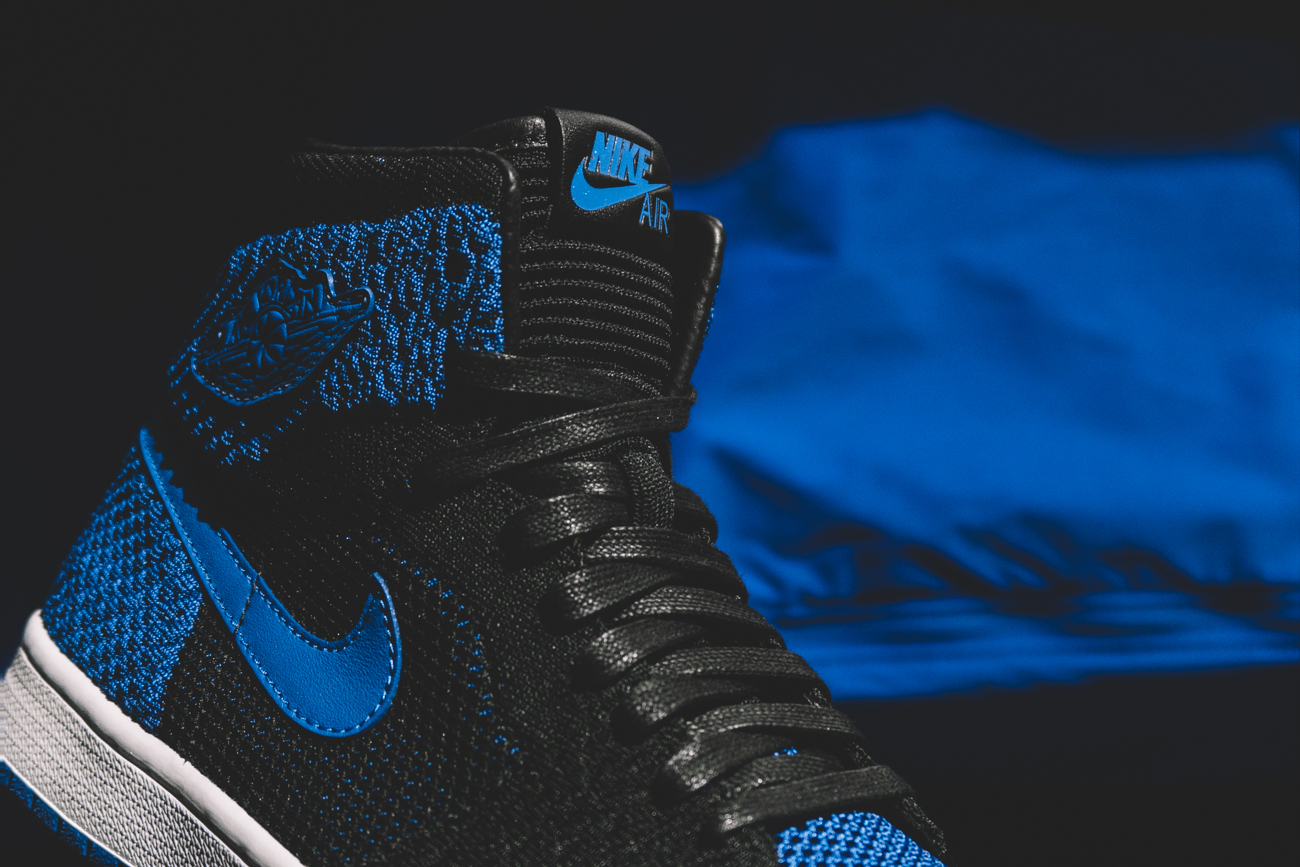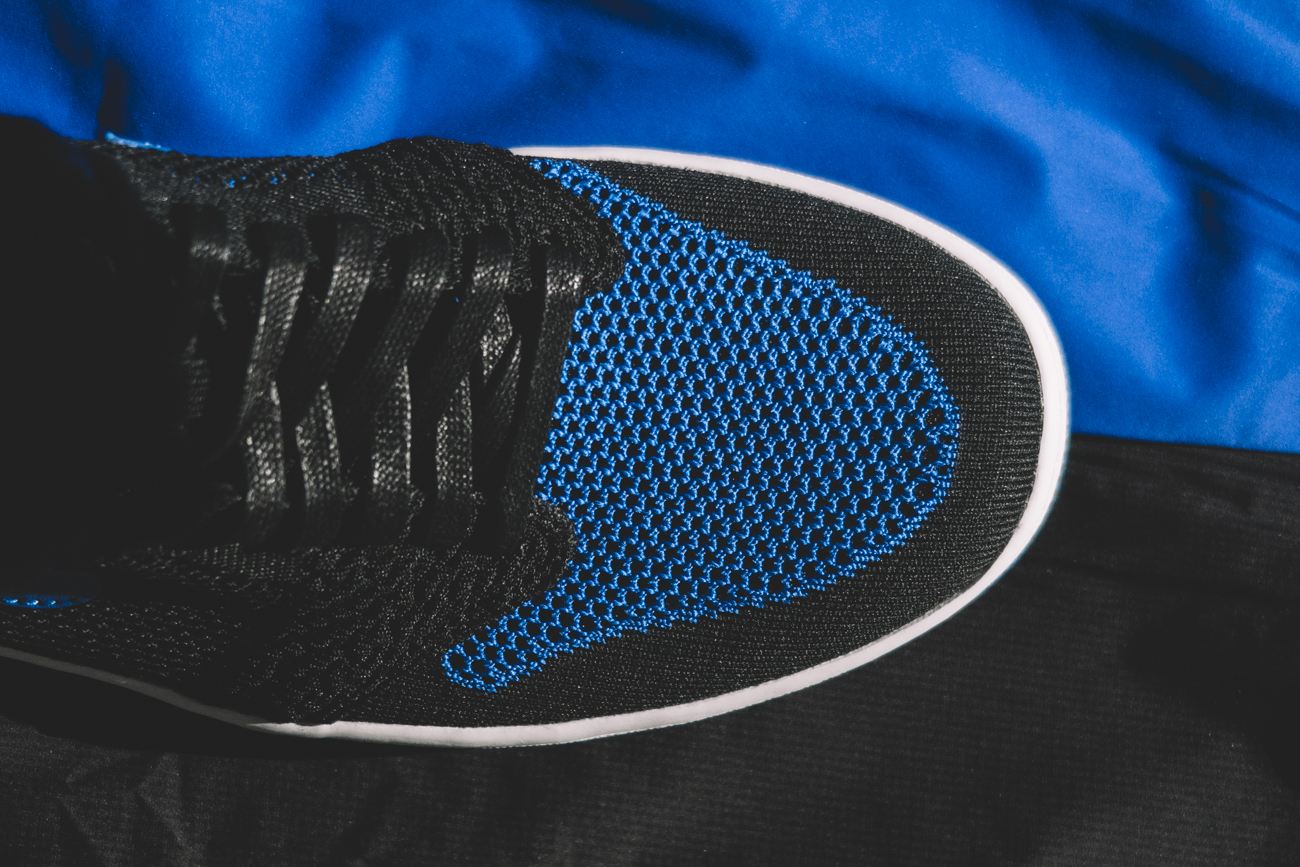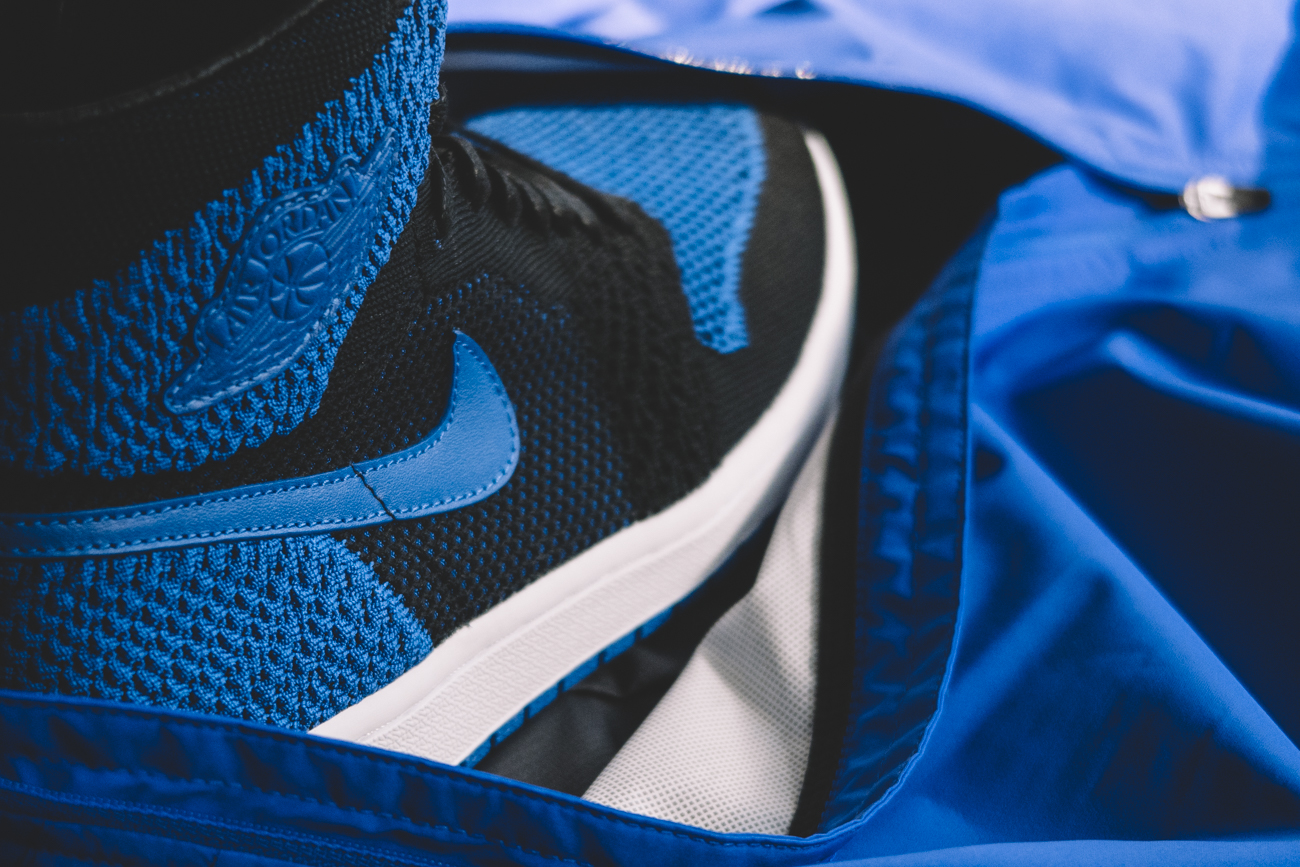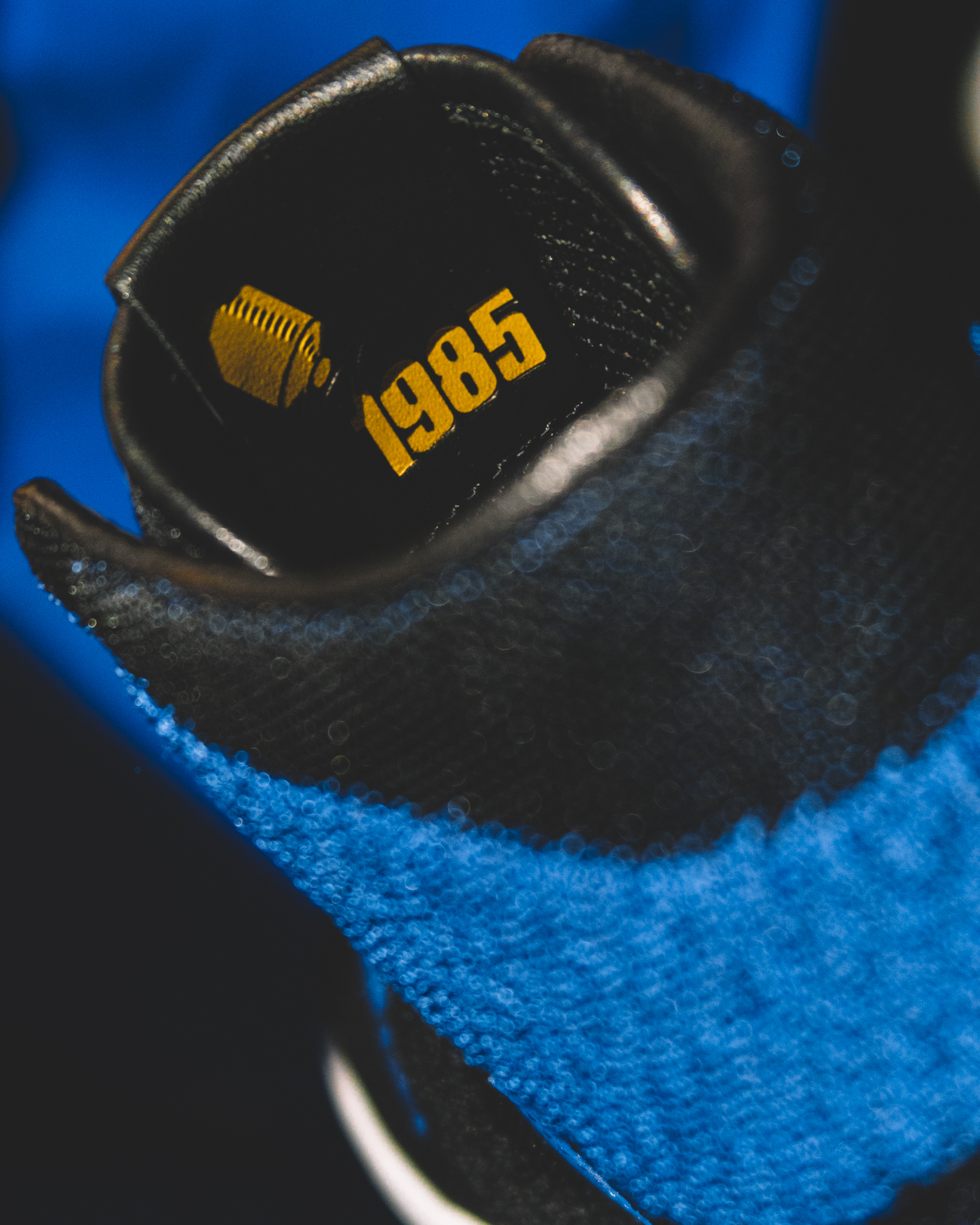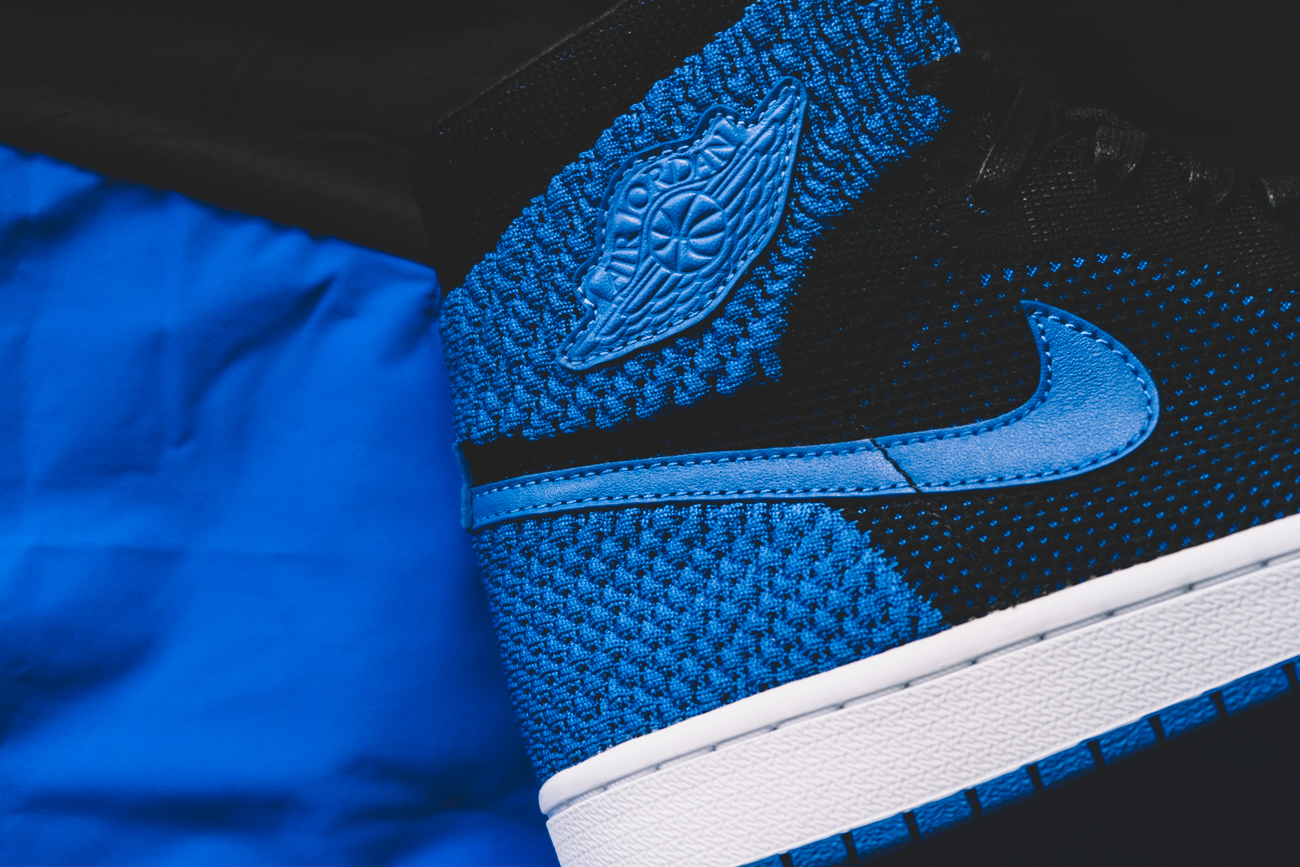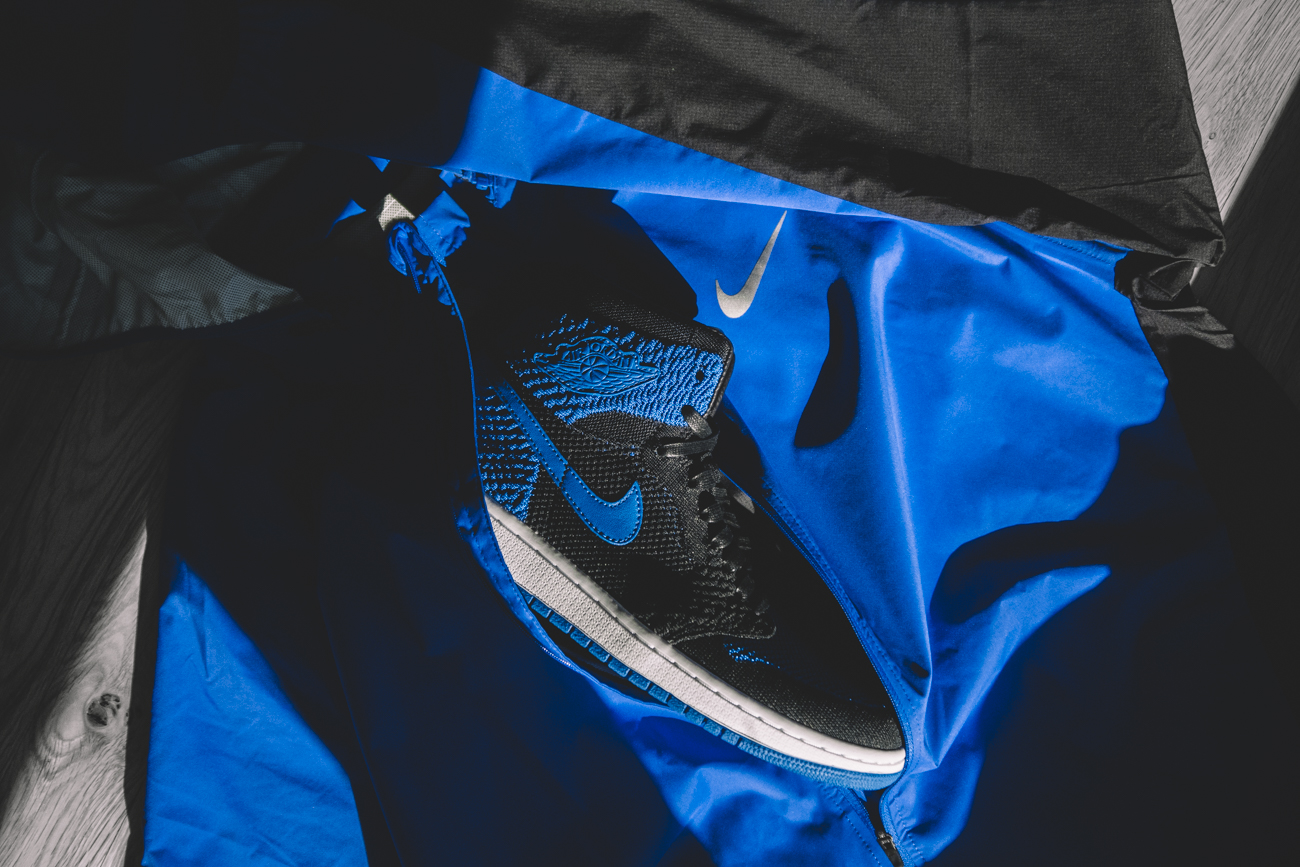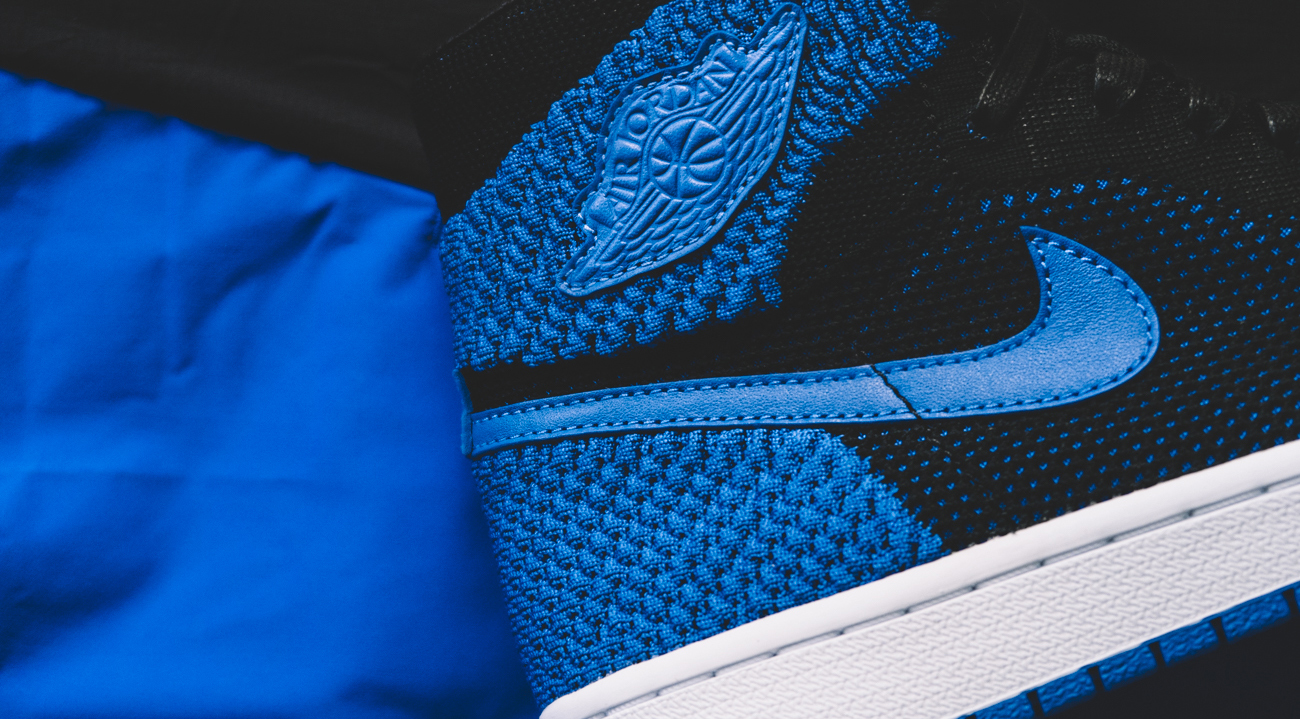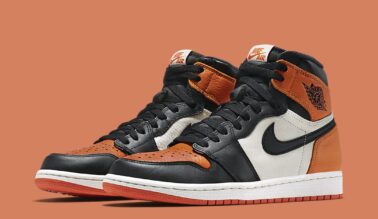This post may contain affiliate links. Please read our disclosure policy.
words & interview // Darren Griffin
photography // Ray P.
Jordan Brand, throughout much of its modern history, has been largely effective in its ability to blend genres to forge new, contemporary products. Utilizing the past as a tool to light a path through the dark and often times unpredictable future has proven savvy for the relatively youthful company. They’ve smartly leaned on their golden-era of design, joining that with what many believe to be a similar period for technological advancements.
The Air Jordan 1 Flyknit encompasses the best of their past happily married to the future of Nike footwear: Flyknit technology – a crowning innovation first introduced back in 2012. The shoe creates an experience both foundational to the Air Jordan 1 and Flyknit, representing an old meets new theme that’s proven effective time and time again.
So, on the heels of the highly regarded Air Jordan 1 Flyknit “Royal” release this weekend, we spoke with Andrew Winfield, Footwear Designer for the Jordan Sportswear Team, and one part of a larger team that designed the Air Jordan 1 Flyknit. Winfield, both a design pro and an Air Jordan 1 enthusiast that ranks the Air Jordan 1 Nouveau “BHM” from 2016 as his favorite of all time, spoke to the shoe’s long and detailed design process, why it was important to start with the “Bred” and “Royal” colorways and which Flyknit retros could be next.

Nice Kicks: How long ago did the idea for an Air Jordan 1 Flyknit come about? Then, from that point, how long until the shoe was completed?
Andrew Winfield: The idea has been around for a while now. It was about a year and a half, two year process. The biggest thing we had to solve is what does Flyknit mean, aesthetically and functionally, for sportswear and for Jordan overall? How does that look and how does that function, and where do we want to take it? That was a big part of the process.
Nice Kicks: Flyknit, in general, seems like an easier fabric to manipulate as opposed to leather, but maybe a little harder to form proper shaping and structure for a Jordan 1. Explain the process of molding the shoe to ensure it felt and wore like a Jordan 1.
Andrew Winfield: Well, given the complexities of knit geometry, you might have more of an open knit structure or a tighter, more closed knit structure. Alternatively, you’re trying to turn a flat knitted pattern into three-dimensional foot form, a process that requires a lot of time and patience. So the propensity for the different knit structures to expand and to track when you’re trying to shape this two-dimensional flat into a three-dimensional sock, it’s something that you have to monitor. Especially for the proportions of this knit to match the OG proportions. If you don’t, the shoe can come off looking kind of janky.
So for that process we had to work in tandem with our knit programmer. The Knit Programmer on this model was Erin Stevens. She did a great job. We worked with her to finalize the finished product and to make sure all the proportions matched, ensuring it looked and it felt like a classic OG Air Jordan 1.
Nice Kicks: Were there any variations of the shoe that got left on the cutting room floor? Or was the process itself something that eliminated that possibility?
Andrew Winfield: So that whole process, when we were figuring out what type of knit geometry we wanted to use, that’s a whole process in itself. Our knit programmer will come with different options. Of course, she’ll take from the direction that we give her, but she’ll also come with other options. But it’s also about what makes sense for this product.
This was a very long and extensive process. It took some time. It’s a lot of back and forth, back and forth; what makes sense. Then the knit programmer has to unify the all geometry to create this three-dimensional form, and that process will blow your mind.
Nice Kicks: Leather is a big part of this shoe and, of course, Air Jordan 1 history. You guys implemented leather at the Swoosh, Wings logo, heel tab and liner. Why was that intersect important as opposed to an all-Flyknit Air Jordan 1?
Andrew Winfield: At the end of the day, while we’re creating functional product, we need to tell stories that connect. Keeping the Swoosh and the Wings logo is our connection, our bringback to the OG AJ1. We though it was a good call back. The leather binding, the matte black base tips; these things speak to our focus on finishing the product the way we see fit. It’s just that last 10 percent that consumers don’t see until they have the product in hand.
Nice Kicks: For many – myself included – this is the most comfortable Air Jordan 1 they’ve ever worn. Which says a lot considering a shoe with over three decades of history. Where did comfort weigh on what the design team was attempting to do with the shoe? Because, ultimately, you’ve created the most comfortable Air Jordan 1 ever by many estimations.
Andrew Winfield: We wanted to give the knit structure a very opulent, lofted feel. We wanted you to be able to close your eyes and still feel the original patterns of the AJ1. We also wanted to make sure the stitch had the proper stance and bulk. Lots of times knit can be very deconstructed, to the point where it can collapse. We wanted this shoe to have the proper stance of the original AJ1. With knit you’re going to get a nice, breathable shoe. We wanted to ensure fans got that immediate glove-like comfort that comes with Flyknit.
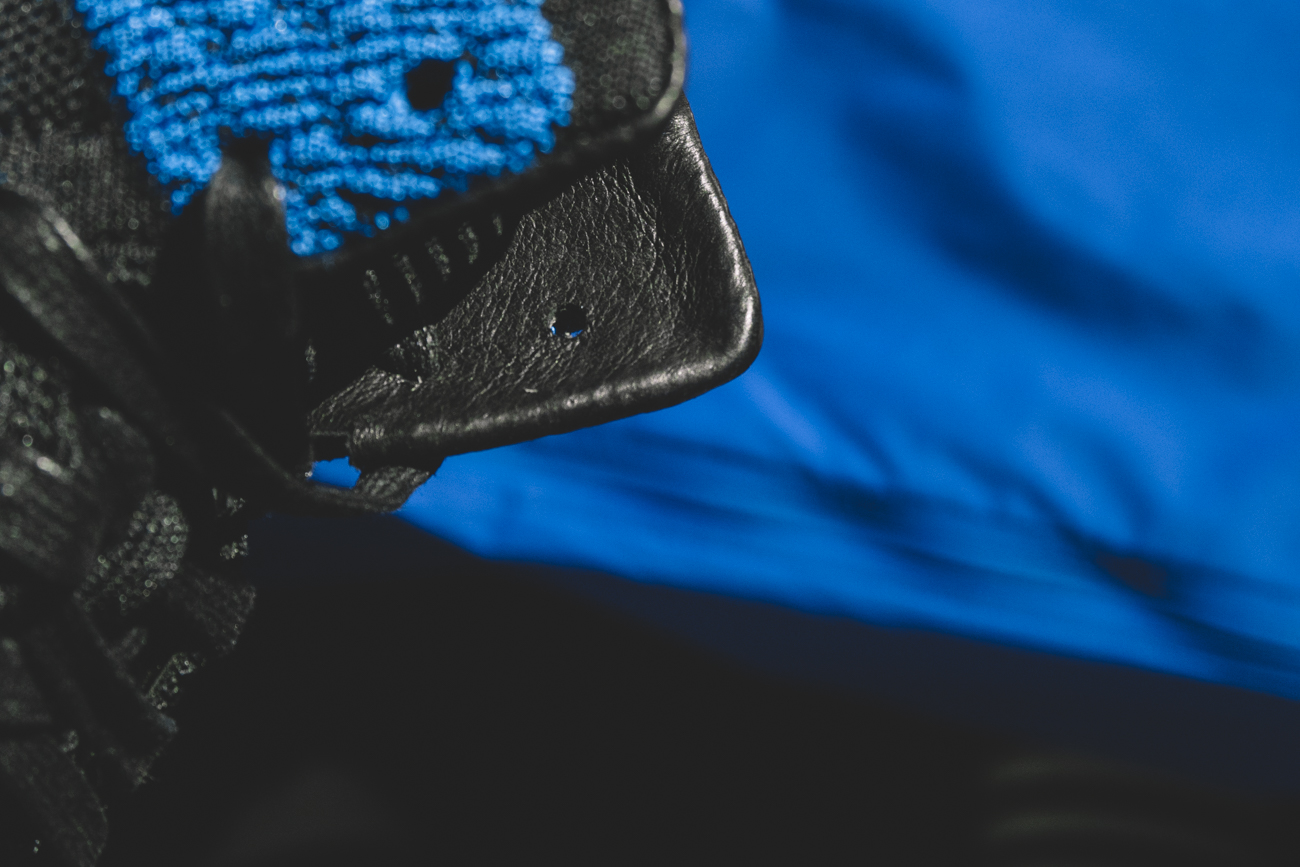 Nice Kicks: Thinking back to 2007 and the Beginning Moments Pack, which featured special insoles, it marked a critical turning point for the Air Jordan 1 where comfort is concerned. The same, of course, can be said now for the Flyknit AJ1. Given the level of comfort has been significantly raised, and will continue with the “Royal” release this weekend, do you foresee a greater emphasis on comfort moving forward? Premium liners, insoles, etc. on traditional leather pairs?
Nice Kicks: Thinking back to 2007 and the Beginning Moments Pack, which featured special insoles, it marked a critical turning point for the Air Jordan 1 where comfort is concerned. The same, of course, can be said now for the Flyknit AJ1. Given the level of comfort has been significantly raised, and will continue with the “Royal” release this weekend, do you foresee a greater emphasis on comfort moving forward? Premium liners, insoles, etc. on traditional leather pairs?
Andrew Winfield: We try to stay true to our original models. Of course given the opportunity, if the consumer is asking for it, we’ll try to pursue it. As far as the AJ1 Flyknit goes we plan on continuing to build the shoe like the first “Bred” colorway. So all the shoes should be built that way. “Royals” included.
But obviously if you think of the brand, and Nike in general, we always look to evolve. So if there’s an opportunity to evolve and make things better we always look into that opportunity and pursue that direction.
Nice Kicks: Right. And I think the community has felt that most recently with the “Breds,” “Royals” and “Shattered Backboards” before that. Which brings about another thought: Why Flyknit 1s? Why not just more traditional premium leather pairs?
Andrew Winfield: I would say that we’re not really choosing Flyknit over leather. As a brand, we saw an opportunity to provide the consumer with a different experience. If you can diversify your lineup, why not?
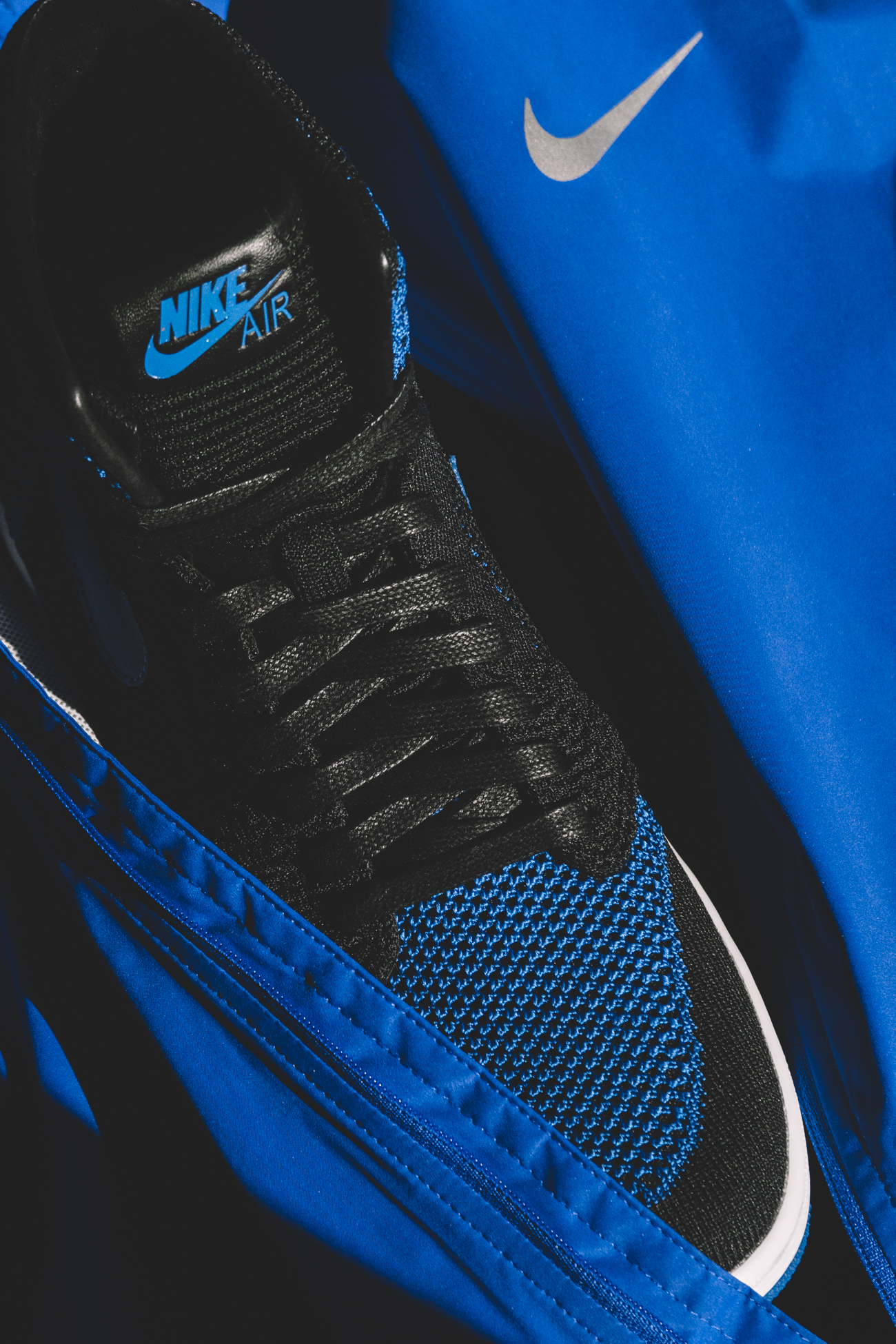
Nice Kicks: I agree. I think it’s one of those things that people didn’t really know that they wanted until they got it.
Andrew Winfield: A lot of times we’re not really getting very specific direction from our consumers unless we’re extremely lucky. We get ideas and we have to build that into something that’s tangible and relevant for them. Flyknit is relevant. Air Jordan 1s are relevant. Everybody wants a comfortable shoe. It’s up to us to make sure that we maintain the right experience that will help our consumer in all their endeavors, whether that’s style, function. We just want to create a fulfilling experience.
Nice Kicks: You guys started with the “Bred” and now the “Royal” this weekend, arguably the two most sought after and historically rich Air Jordan 1 colorways. Do you think it was imperative to start this project with those two pairs? To both resonate with brand purists and youthful consumers alike?
Andrew Winfield: Well yeah, those are very iconic colorways. So we definitely wanted to ground the innovation of Flyknit with the heritage and legacy of MJ with those two iconic colorways first. What I can say is that there will be other OG colorways coming.
Nice Kicks: So, that said, why didn’t you guys start with the “Chicago” in lieu of one of the other pairs? Was there a thought behind that or was it just the general consensus of the design team and others involved?
Andrew Winfield: I mean the “Bred” colorway is obviously iconic just because its the “Banned” colorway. It’s part of what sparked that resurgence of the retro market. They sort of built that initial allure outside of just people who were MJ fans. They became a fan of the shoe as well. So the “Bred” colorway had a lot of impact from a larger scope. Given that this is Flyknit, and our first introduction as far as legacy goes, it made sense. This is off-court, this is more of a lifestyle thing – a cultural thing. So it made sense for us to start with the “Bred” as opposed to the “Chicago.”
Nice Kicks: Considering Flyknit is now in play with Jordans, there’s a wealth of possibilities. More OGs like you mentioned, Mids, Lows, Multicolor pairs, etc. Do you foresee any of those things happening?
Andrew Winfield: What I can say is that we’ll work where it makes sense for our consumer. If we see an opportunity to improve the consumers experience, then it will only make sense for us to explore that route.
But, you know, you can kind of guess just based off of Nike’s history and Jordan’s history that if it makes sense we’ll pursue it.
Nice Kicks: I do think that it makes sense given the Air Jordan XXX2 is a throwback to the Air Jordan 2 but also a look to the future in its implementation of Flyknit. It looks to be a growing theme. What are your thoughts on how Flyknit can or will play a role with retros moving forward?
Andrew Winfield: Flyknit isn’t going anywhere. There’s a tremendous amount of opportunity with how we can apply it to different product, whether that’s on or off court. Much of that is to be determined at this moment. But what I’ll say is that Flyknit isn’t going anywhere because people simply want a more comfortable shoe.
Grab an exclusive detailed look at the “Royal” Air Jordan 1 Flyknit ahead of its release slated for October 7th retailing for $180.

